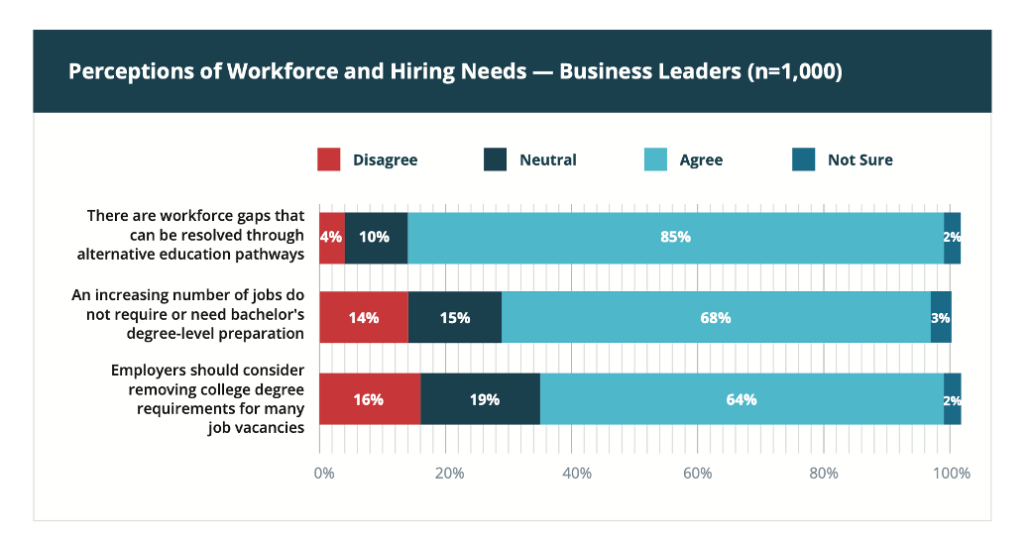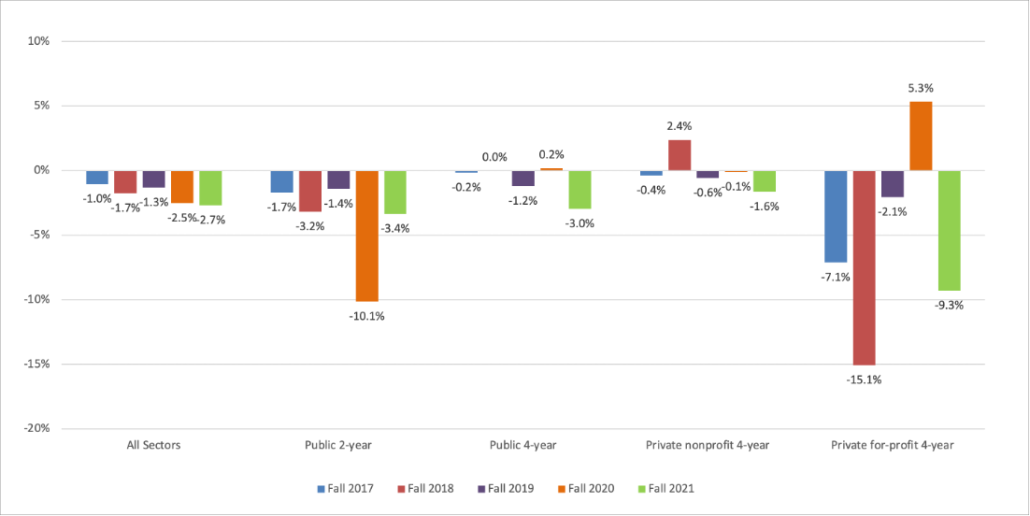We all know the demand for earning a four-year degree continues to decrease. If there’s a silver lining, it would clearly be the proliferation of alternative postsecondary education pathways.
Let’s begin with a definition of “alternative pathways” from BestColleges.com:
“Alternative education pathways [are] defined as employment-related skill development opportunities that prepare a learner for work, but do not require or result in a college degree.”
These opportunities have made their way to the forefront of higher ed in recent years due to a variety of factors, including rising concerns about “degree inflation” (in which degree requirements for employment are padded or “inflated” in job postings), as well as COVID-19 and the subsequent “Great Resignation” that took shape as millions of Americans left their jobs to reassess their careers.
Let’s explore some of the top reasons why alternative education pathways are enjoying newfound popularity and why looking at tertiary education through a non-traditional lens is a useful strategy for post-pandemic-era students.
We’ve also included some prompts for how to become a non-degree champion, even if your institution is still faithful to the conventional higher ed diploma.
So, why are alternative postsecondary programs gaining momentum?
Traditional higher ed is stalling
Even before the cataclysmic events of 2020, higher ed enrollments were on a mostly downward trajectory. In fact, enrollment percentages have witnessed a near-consistent decline starting as far back as 2017, with affected sectors ranging from public two-year to private four-year institutions.
Just as COVID-19 caused American workers to re-evaluate their careers, it also appears to have inspired would-be students to re-examine their educational choices.
Research from National Student Clearinghouse points to a 4% decrease in undergrad enrollment from 2019 to 2020 and a whopping 22.7% downturn for first-time enrollees to community college. Meanwhile, a September 2021 survey from the Educational Credit Management Corporation Group (ECMC) and VICE Media signals a decisive shift in high schoolers’ academic aspirations, citing:
- only 48% of respondents are planning to pursue a four-year college degree
- 53% feel professional success can be achieved with just three years of education (or fewer)
- 69% believe on-the-job experiences (via internships, apprenticeships, etc.) should be part of their postsecondary education
Such statistics suggest general interest in a standard academic path is waning and prospective higher ed students are on the hunt for something new—preferably something that prepares them for steady, gainful employment.
Quicker and less expensive alternatives carry renewed appeal
Since the pandemic, students of all ages have been leaning toward educational programs more aggressively tailored to the jobs they want: a notable departure from broader educational templates that frequently cover a variety of disciplines over a longer period of time.
Among younger students, about a third of prospective Gen Z enrollees are drawn to educational experiences delivered in one year or less (per ECMC), indicating a trend that favors vocationally driven programs like apprenticeships or shorter training “bootcamps.”
For adults already in the workforce, interest in supplemental education (which may or may not carry a degree) also appears to be on the rise. A full 33% of respondents to a Strada Education Network survey felt they would need further education were they to lose their jobs post-COVID, with 29% reporting they’d prefer to spend their educational dollars on alternative pathways such as apprenticeships or third-party provider courses online. And, according to a 2021 report on alternative education, a majority of U.S. adults believe non-traditional avenues of education yield “good return on investment”— while 55% of the general public agreed alternate ed will become a crucial part of workforce training in the coming years.
“Pathways” in such cases correspond to a variety of educational options: from technical training to certifications or “microcredentials” from online juggernauts like Coursera; immersive journeyman programs; and non-degree classes at degree-granting institutions. These opportunities are often “stackable,” meaning they can sometimes serve as the foundation for further, even higher levels of certification.
And sometimes these options can pay dividends even without the “stacking.”
Not only can non-traditional programs cost much less (one certificate at Purdue University is about a fifth the cost of a typical associate’s degree at the same institution), they can also translate into sizeable salaries. Depending on the industry, non-degreed workers occasionally see a marked increase in income if they hold a relevant certificate (compared to median annual intake if they don’t). In 2019, Gallup and Strada found the median income among non-degreed credentialed workers between 24 and 65 to be around $15,000 more than non-degreed employees without similar accreditation—all of which strongly suggests alternative pathways are far better than no education at all.*
*Note: Self-funded alternative programs, which account for many of today’s non-degree options, are ineligible for government financial aid. This means the entire cost can come out of the student’s pocket. Plus, wage premiums for certified workers don’t always hold true across industry or gender.
Schools are already getting in on the act… and so are employers
With many community colleges—in addition to academic stalwarts like Purdue and Brown—offering certifications across diverse disciplines, the advent of the non-degree has been a reality for quite some time. So much so that organizational efforts like those of the Pathways to Prosperity Network (established in 2012) have also gained ground throughout the U.S., connecting students to business and educational resources aimed primarily at labor market prep.
And if employers aren’t involved in this type of training (as many already are), there’s a good chance they’re highly interested in the kind of employees this training can produce.
Google, Apple, IBM, and Accenture, for example, have all cut back on degree requirements for their IT jobs, though many positions still demand a traditional postsecondary diploma to get applicants through the door. Still, an impressive 68% of business leader respondents to the 2021 alternative pathways report felt an increasing number of jobs on the market do not need or require bachelor-level education, with 85% citing alternative pathways as a possible cure for current “workforce skill gaps.”
85% of business leaders believe alternative ed can help ease workforce skill set and vacancy challenges.

These findings indicate a rethinking of what it takes to succeed: a new level of cultural acceptance for different forms of postsecondary learning, particularly when they’re conducted or informed by industry professionals.
As Marina Irfan, enrollment and success manager at UT Austin observes:
“Employers increasingly are seeking candidates with specific skill sets who are ready to be productive on day one. Certificate programs are built with significant input from industry experts and often focus on [those requisite] skill sets.”
Higher ed institutions have a role to play, too
Recent dips in enrollment should serve as a “wakeup call” to postsecondary practitioners:
The time to take alternative pathways seriously is now.
But, other than reconfiguring curriculums to accommodate new, non-degree programs, what can traditional institutions do to ride the alternative wave and support students seeking innovative ways to set themselves up for a sustainable career?
A few ideas:
- If you don’t offer vocation-specific courses or industry-specific certification programs, help connect prospects and recent grads with organizations that do. Investigate job counseling services and/or partnerships with local and national businesses that direct both young and older students to effective training through real-world apprenticeships, paid internships, online tech bootcamps, extensive third-party crash courses, etc.
- If you do provide alternative credential programs, reach out to students who might be struggling on the road to a regular paycheck. Offer guidance on employer tuition reimbursement, government-funded grants, or other forms of financial aid. It’s also advisable to establish contacts with recruiters from reputable companies so students have an in-built employment pipeline at their disposal.
Your institution can help promote alternative ed by forming partnerships, providing guidance, and spreading the word about the current non-degree trend.
- Spread the word. Sometimes all that stands between a student and their dream job is a lack of awareness regarding their educational opportunities. Alert prospects to the benefits of alternative pathways and non-degree trade programs wherever appropriate. Encourage potential students to think of learning as an evolving pursuit that can change according to their needs and desires (as opposed to an unforgiving model where training is only delivered full-time over four years).
- Help end the stigma. The conventional degree isn’t going anywhere, but the non-traditional path to qualified education is here to stay. And given the many advantages alternative pathways can afford today’s non-degreed workers (an estimated 50% of the working population), these programs have earned their place in the higher ed conversation. Be sure not to discount them when you review options with students looking to improve their employability.
For more on boosting employability quotients for typical four-year students, see our post on cultivating bankable skills for viable careers through old-school higher ed.










